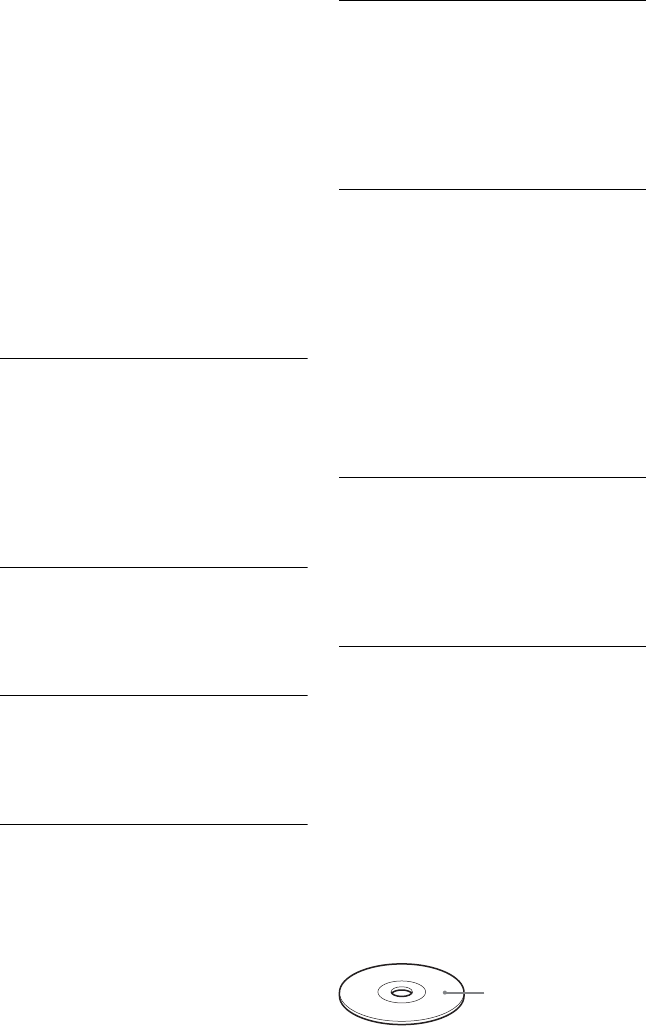
D:\SONY DVD\2591934111 DVP-
NC80V\SOURCE\DVP-
NC80V_US\01US14ADD-CEK.fm
master page=left
78
DVP-NC80V
2-591-934-11(1)
9.4 GB, and double-layer and double-sided
DVD is 17 GB.
The picture data uses the MPEG 2 format, a
worldwide standard of digital compression
technology. The picture data is compressed to
about 1/40 (average) of its original size. The
DVD also uses a variable rate coding
technology that changes the data to be
allocated according to the status of the
picture. Audio information is recorded in a
multi-channel format, such as Dolby Digital,
allowing you to enjoy a more realistic audio
presence.
Furthermore, various advanced functions
such as the multi-angle, multilingual, and
Parental Control functions are provided with
the DVD.
DVD-RW (page 7)
A DVD-RW is a recordable and rewritable
disc that is the same size as a DVD VIDEO.
The DVD-RW has two different modes: VR
mode and Video mode. DVD-RWs created in
Video mode have the same format as a DVD
VIDEO, while discs created in VR (Video
Recording) mode allow the contents to be
programmed or edited.
DVD+RW (page 7)
A DVD+RW (plus RW) is a recordable and
rewritable disc. DVD+RWs use a recording
format that is comparable to the DVD VIDEO
format.
File (page 53, 56)
A JPEG image recorded on a DATA CD/
DATA DVD (“File” is an exclusive
definition for this player.) A single file
consist of a single image.
Film based software, Video based
software (page 19)
DVDs can be classified as Film based or
Video based software. Film based DVDs
contain the same images (24 frames per
second) that are shown at movie theaters.
Video based DVDs, such as television
dramas or sit-coms, displays images at 30
frames/60 fields per second.
Normal (Interlace) format (page 19)
Normal (Interlace) format shows every other
line of an image as a single “field” and is the
standard method for displaying images on
television. The even number field shows the
even numbered lines of an image, and the odd
numbered field shows the odd numbered lines
of an image.
Progressive format (page 19)
Compared to the Interlace format that
alternately shows every other line of an image
(field) to create one frame, the Progressive
format shows the entire image at once as a
single frame. This means that while the
Interlace format can show 30 frames/60 fields
in one second, the Progressive format can
show 60 frames in one second. The overall
picture quality increases and still images,
text, and horizontal lines appear sharper. This
player is compatible with the 480 progressive
format.
Progressive JPEG
Progressive JPEGs are used mostly on the
internet. They are different from other JPEGs
in that they “fade in” gradually instead of
being drawn from top to bottom when
displayed on a browser. This lets you view the
image while it is being downloaded.
Super Audio CD (page 7)
A Super Audio CD disc can reproduce sounds
that are extremely faithful to the original
sound by use of DSD (Direct Stream Digital)
technology. This technology utilizes a
sampling frequency of 2.8224 MHz, which is
64 times that of a conventional CD, and 1-bit
quantization that enables the disc to hold 4
times the amount of information that a
standard PCM format CD can hold. Super
Audio CDs are divided into the following
types.
• Super Audio CD (single layer disc)
This disc consists of a single HD layer*.
*High density signal layer for the Super Audio CD
HD (high density) layer
01ΥΣ01ΧΟς.βοοκ Παγε 78 Τηυρσδαψ, Φεβρυαρψ 24, 2005 4:00 ΠΜ


















